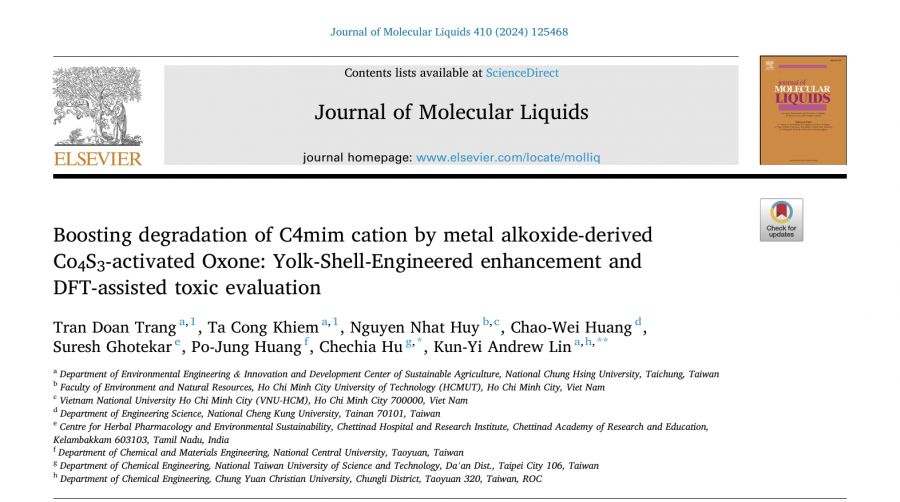循環農業:農業剩餘資材及生質衍生物高值化轉換再利用【環境工程學系/林坤儀特聘教授】
| 論文篇名 | 英文:Boosting degradation of C4mim cation by metal alkoxide-derived Co4S3-activated Oxone: Yolk-Shell-Engineered enhancement and DFT-assisted toxic evaluation 中文:透過金屬醇鹽衍生的 Co 4 S 3活化的 Oxone促進 C4mim 陽離子的降解:蛋黃殼工程增強和 DFT 輔助毒性評估 |
| 期刊名稱 | Journal of Molecular Liquids |
| 發表年份,卷數,起迄頁數 | 2024, 410: 125468 |
| 作者 | Trang, Tran Doan; Khiem, Ta Cong; Huy, Nguyen Nhat; Huang, Chao-Wei; Ghotekar, Suresh; Huang, Po-Jung; Hu, Chechia; Lin, Kun-Yi Andrew(林坤儀)* |
| DOI | 10.1016/j.molliq.2024.125468 |
| 中文摘要 | 室溫離子液體 (RTIL) 的低生物降解性使 RTIL 成為一類新型持久性污染物。迫切需要開發有用的技術來消除 RTIL,以防止它們在環境中出現。硫酸根高級氧化製程(SR-AOP)特別適合降解此類低生物降解性污染物。本研究介紹了一種新型 SR-AOP,旨在消除代表性 RTIL,即氯化 1-丁基-3-甲基咪唑鎓 (C4M),使用增強型催化劑來活化 Oxone。傳統上,鈷 (Co) 已用於 Oxone 活化,但 Co 離子的均相催化帶來了回收挑戰和二次污染風險。最近的研究表明,硫化鈷 (CS) 因其優異的氧化還原特性而更有前景,這對於有效活化 Oxone 至關重要。在這項工作中,我們開發了一種由硫化鈷(CS)組成的催化劑,具有獨特的蛋黃殼(YS)結構,稱為YSCS,以最大限度地提高催化活性。 YSCS 很容易由 Co-Glycerate (CoG) 前驅物通過硫化過程中的自毀/重建過程製成,從而形成被自組裝 Co4 S3奈米板覆蓋的 YS 結構。這種形態提供了高度介孔結構、增強的電化學性能和擴大的活性位點。因此,與其前體CoG和基準Co 3 O 4相比,YSCS表現出明顯更高的Oxone活化催化活性,反應速率常數(k)為0.108 min -1,超過了Co3 O4 NP + Oxone(0.007 )分鐘-1 ) 和 CoG + Oxone (0.023 分鐘-1 )。此外,YSCS + Oxone 的 C4M 降解活化能 ( Ea ) 較低,為 17.8 kJ/mol。使用 Fukui 指數並分析降解副產物,徹底研究了 YSCS + Oxone 對 C4M 的降解路徑。毒性評估表明,YSCS + Oxone 顯著降低了 C4M 的急性毒性和生物濃縮係數,以及潛在的致突變性和發育毒性風險。這些發現證實,YSCS 是水中 Oxone 活化和 RTIL 降解的高效催化劑。 |
| 英文摘要 | The low bio-degradability of room-temperature ionic liquids (RTILs) makes RTILs a new class of persistent contaminants. It is urgent to develop useful technology to eliminate RTILs to prevent their presence in the environment. Sulfate-radical advanced oxidation processes (SR-AOPs) are particularly suitable for degrading such low-biodegradability pollutants. This study introduces a novel SR-AOP aimed at eliminating the representative RTIL, 1-butyl-3-methylimidazolium chloride (C4M), using an enhanced catalyst to activate Oxone. Traditionally, cobalt (Co) has been used for Oxone activation, but homogeneous catalysis with Co ions poses recovery challenges and secondary pollution risks. Recent studies suggest that cobalt sulfides (CSs) are more promising due to their superior redox properties, which are critical for effective Oxone activation. In this work, we developed a catalyst composed of cobalt sulfide (CS) with a unique yolk-shell (YS) structure, termed YSCS, to maximize catalytic activity. YSCS was easily fabricated from Co-Glycerate (CoG) precursors through a self-destruction/reconstruction process during sulfidization, resulting in a YS structure covered by self-assembled Co4S3 nanoplates. This morphology provides a highly mesoporous structure, enhanced electrochemical properties, and expanded active sites. Consequently, YSCS demonstrated significantly higher catalytic activity for Oxone activation compared to its precursor CoG and the benchmark Co3O4, with a reaction rate constant (k) of 0.108 min-1, surpassing those of Co3O4 NP + Oxone (0.007 min-1) and CoG + Oxone (0.023 min-1). Additionally, YSCS + Oxone exhibited a lower activation energy (Ea) of 17.8 kJ/mol for C4M degradation. The degradation pathway of C4M by YSCS + Oxone was thoroughly investigated using Fukui indices and analyzing the degradation by-products. Toxicity assessments showed that YSCS + Oxone significantly reduces the acute toxicity and bioconcentration factor of C4M, as well as potential mutagenicity and developmental toxicity risks. These findings confirm that YSCS is a highly effective catalyst for Oxone activation and RTIL degradation in water. |
| 發表成果與本中心研究主題相關性 | 透過本研究可進一步建立開發本研究計算所需之觸媒材料,並釐清可適合應用之環境條件! |







